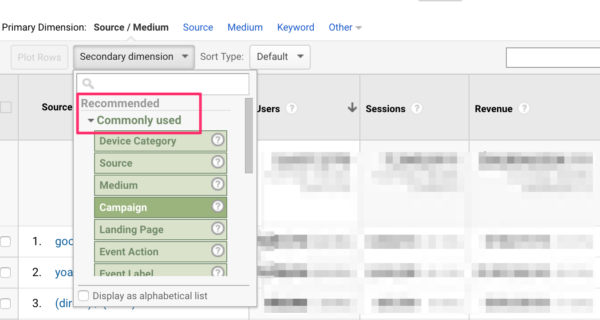Enhance Your Information Evaluation Making Use Of Second Measurement in Google Analytics
Discovering the capacities of additional dimensions in Google Analytics opens a realm of possibilities for refining data evaluation. By layering added dimensions onto key data collections, an even more complex narrative emerges, losing light on individual interactions and performance signs.
Comprehending Secondary Measurements
Second measurements in Google Analytics refer to additional specifications that can be added to the main dimension, permitting for an extra comprehensive evaluation of data (Secondary Dimension in Google Analytics). By integrating additional dimensions, analysts can section and filter data to uncover patterns, trends, and relationships that may not be evident when looking at the information as a whole.

Advantages of Making Use Of Second Measurements
When evaluating data in Google Analytics, the usage of secondary measurements uses very useful insights right into user behavior and efficiency metrics. By adding a second measurement to your primary information, you can delve deeper into the qualities of your website site visitors and their communications.
Furthermore, second measurements aid in determining patterns and correlations that may not be instantly noticeable when looking at the data alone. This much deeper level of analysis can discover beneficial information that can direct advertising techniques, web site optimization, and total organization decisions. Furthermore, additional measurements boost the context of your main data, giving a much more thorough view of customer interaction and efficiency metrics. On the whole, the use of additional measurements in Google Analytics can dramatically boost the depth and high quality of your data evaluation, leading to even more informed decision-making and improved results.
Exactly How to Add Additional Measurements
By including additional measurements in Google Analytics, individuals can acquire deeper understandings into their data evaluation process, permitting more detailed analysis of individual behavior and performance metrics. Including additional dimensions is a straightforward procedure that can significantly boost the depth of analysis. To add an additional dimension in Google Analytics, begin by navigating to the report you intend to assess. Once in the record, locate the "Second measurement" tab over the information table. Click it to expose a dropdown menu with various alternatives such as Behavior, Modern Technology, and Customized Dimensions. Select the measurement you wish to add, such as 'Source/Medium' or 'Device Category'. This additional measurement will Get the facts after that be used to your existing data, providing extra context and permitting for an extra comprehensive analysis of individual interactions. By using secondary dimensions effectively, individuals can reveal useful understandings that might have or else been forgotten, leading to notified decision-making and boosted efficiency approaches.
Studying Information With Additional Dimensions
Utilizing additional measurements in data analysis provides a more comprehensive understanding of individual habits and efficiency metrics. By including an additional measurement to your main information established in Google Analytics, you can delve much deeper into the qualities of your web site site visitors and their communications. Combining the key measurement of 'source/medium' with the additional dimension of 'landing page' can disclose which details pages are drawing in traffic from different sources, assisting you optimize these web pages for far better interaction.

Essentially, analyzing data with secondary measurements empowers you to obtain beneficial understandings right into individual behavior, recognize fads, and make notified decisions to improve the performance of your digital properties.
Ideal Practices for Secondary Measurements
In information evaluation, incorporating second measurements properly can substantially enhance the depth of understandings obtained from metrics and customer habits patterns. When making use of second dimensions this contact form in Google Analytics or any kind of other logical tool, it is important to follow finest techniques to make certain the precision and relevance of the data evaluation.
One key best practice is to thoroughly select additional dimensions that enhance the primary measurement being examined. Choosing additional measurements that provide added context or further segmentation can use a more comprehensive understanding of the data. It is likewise necessary to stay clear of overcomplicating the analysis by consisting of as well several secondary dimensions, which might result in complication or dilution of understandings.
Additionally, it is suggested to experiment with different combinations of additional and key measurements to reveal new relationships and Look At This fads. Consistently fine-tuning the option and evaluating of secondary dimensions based on the certain goals of the evaluation can bring about even more workable understandings. By complying with these best practices, information experts can leverage additional dimensions effectively to improve the total data evaluation procedure and decision-making abilities.

Verdict
In conclusion, including secondary dimensions in Google Analytics is crucial for a comprehensive data analysis technique. By leveraging additional measurements together with main ones, marketers and experts can uncover beneficial insights and correlations that can inform decision-making and optimize electronic advertising approaches. Recognizing exactly how to properly make use of secondary dimensions and adhering to ideal techniques will certainly permit specialists to draw out significant data and boost their total efficiency metrics.
Additional dimensions in Google Analytics refer to added criteria that can be included to the key dimension, allowing for a much more comprehensive analysis of data. By incorporating secondary measurements, experts can section and filter information to discover patterns, trends, and relationships that may not be obvious when looking at the data as a whole. Combining the key dimension of 'source/medium' with the secondary measurement of 'landing page' can disclose which particular web pages are drawing in web traffic from different resources, helping you enhance these pages for better involvement.
One key ideal method is to thoroughly select second dimensions that enhance the primary dimension being evaluated. By adhering to these best techniques, data analysts can leverage secondary measurements successfully to improve the general information analysis process and decision-making capabilities.